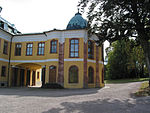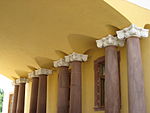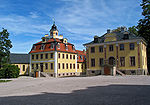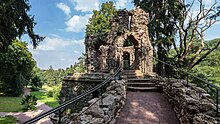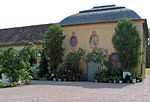Belvedere (Weimar)

The castle Belvedere is a lushly landscaped pleasure palace complex near the city of Weimar . The Belvedere is one of the most beautiful residences in Thuringia. The entire complex, including the park with its many exotic plants, was declared a World Heritage Site by UNESCO in 1998 as part of the “ Classical Weimar ” ensemble .
location
The castle with its numerous outbuildings and a landscape park including orangery is located on the Eichenleite near Weimar, a hill about four kilometers south of the city center. The castle can be reached via the representative Belvederer Allee , which runs as a straight axis from the city center up to the Eichenleite. The grounds of the palace complex slopes down to the north and allow a wide view of the city of Weimar.
Belvedere Palace
The attachment
The yellow-colored castle is divided into a dominant central building with a small observation tower and two side pavilions with domes, each resting on 8 pairs of columns. It stands on the south side of a round forecourt with a “castle fountain”, around which the symmetrically laid out “cavalier houses” are grouped. Today these are known under the names Beethovenhaus and Bachhaus in the east and Mozarthaus and Haydnhaus in the west.
Inside the castle, the access area is already to be emphasized, which is equipped with four pictures made of tiles in Delft blue with typical Dutch motifs such as sailing ships, windmills, etc. This is an ingredient from the late 19th century. There are a great many faiences on Belvedere, also from earlier times, which presumably come from local production.
- Belvedere
history
The baroque palace complex was built between 1724 and 1744 by Johann Adolph Richter and Gottfried Heinrich Krohne as the residence for Duke Ernst August I of Saxe-Weimar and was one of the most important of his around twenty hunting and pleasure palaces . The Belvedere Palace in Vienna served as a model .
From 1756 until the transfer of ownership to the state of Thuringia in 1921, Belvedere Palace was subject to various uses. From 1806 to 1853/59 it served the Weimar Princely House (Hereditary Grand Duke Carl Friedrich and his wife Maria Pavlovna ) as a representative summer residence . In the transition from the 18th to the 19th century, parts of the facility were already leased to a private school.
Today the castle buildings are open to visitors again after extensive renovation work. In the actual castle, a Rococo museum was set up by the Weimar art collections , the exhibition of which shows important paintings and portraits from the 17th, 18th and early 19th centuries. The focus of the collection is on exquisite glasses, porcelain, faience and furniture.
Today the cavalier houses are predominantly used by the "Franz Liszt" University of Music as practice and study rooms for singers, guitarists and accordionists.
Belvedere Palace Park with orangery
The 43 hectare Belvedere Palace Park was originally laid out around the palace in the time of Duke Ernst August I between 1728 and 1748 as a representative, baroque garden in a strict French style. A star-shaped zoo was built directly behind the castle and an orangery was built in the eastern part of the park . The buildings of the orangery, begun in 1731, were completed in their first baroque version around 1750 , based on the designs of the master builder Johann Adolph Richter . The Long House followed in 1760 , and in 1808 the Orangery was expanded to include the New House .
After 1758 the symmetrical garden structure gradually dissolved . Among other things, the cabinet gardens surrounding the castle were removed and some buildings disappeared. From 1811, under Hereditary Grand Duke Carl Friedrich, the redesign took place in the sense of an English landscape park with numerous architectures and decorative places in the slope area. For his wife, the Tsar's daughter Maria Pavlovna , Carl Friedrich had the regularly designed Russian garden laid out from 1811 to 1815 , to which a small hedge theater was added in 1823 and the maze in 1843 , which adjoins the arcade . The Russian Garden is a miniature replica of the Supreme Garden at the summer residence of the Tsars in Pavlovsk . There is also a bluebell tree named after the Grand Duchess' sister, Anna Pavlovna , in it . The enclosing wall of the castle park was finally removed in 1844/45, which enabled the transition to the adjacent forest.
The orangery, which was originally intended only for representation, even achieved fame around 1820 as the Hortus Belvedereanus with its Belvederer plant collections . In 1820 August Wilhelm Dennstedt , with the help of the court gardener Johann Christian Sckell , realized the first delivery of a plant directory, which was published by Friedrich Justin Bertuch . At that time, Johann Wolfgang von Goethe and Grand Duke Carl August often stayed in the Belvedere greenhouses for scientific studies and botanical experiments. In the years 1818–1821, the so-called Red Tower was built next to the Long House at the flower garden, which was painted by Adam Friedrich Oeser (now reconstructed) and was used as a botanical cabinet. From here you have the best view of the area. The tower also served as a tea house.
By the middle of the 19th century, the formation of the park, which had been carried out since 1842 according to the proposals of Prince Pückler-Muskau , was completed in its current form of a post-classic-romantic landscape park with decorative places, water and grotto facilities, sentimental monuments and ruin architecture. The baroque layout can still be seen in the ensemble of buildings.
The castle was largely spared during the Second World War . In 1945 the Red Army established its headquarters in the castle. In 1946 a central Soviet cemetery for the occupying power in Thuringia was set up in the area between Belvederer Allee and the palace building . In 1937/38 it was laid out as a cemetery of honor for the National Socialists by Fritz Sauckel . After the end of the war, the few buried were reburied in the Weimar main cemetery. From 1946 to 1975, well over 2,000 burials of Soviet military and civilians took place here.
In 2004, a comprehensive restoration of the gardens was largely completed. The orangery together with the gardener's house still houses exotic plants that, when placed outdoors in summer, give the entire complex a Mediterranean flair. Historic sewer heating ensures the right temperatures in winter. Until 2000, part of the building complex served as an exhibition space for carriages , hunting wagons and coupés from the 18th and 19th centuries from the former grand ducal vehicle fleet. The carriage museum is located in Auerstedt Castle .
The Belvedere Palace Music High School is located in a new building north of the historic palace complex, which was carefully and successfully integrated into the landscape in terms of landscape architecture .
- Orangery Belvedere Palace
literature
- Werner Deetjen : Belvedere Palace . JJ Weber publishing house in Leipzig, Leipzig 1926 (1936 new edition: Weberschiffchen-Bücherei 18).
- Sibylle Hoiman: The Orangery in Belvedere near Weimar - nature and architecture in the context of courtly representation 1728–1928. Dissertation, TU Berlin 2015.
- Heiko Laß and Maja Schmidt: Belvedere and Dornburg. Two pleasure palaces of Duke Ernst August of Saxe-Weimar. Michael Imhof, Petersberg 1999.
- Bettina Paust: The menagerie of the Belvedere pleasure palace near Weimar . In: Die Gartenkunst 6 (2/1994), pp. 237–248.
- Reinhard Schau : The Weimar Belvedere. An educational institution between the time of Goethe and the present. Böhlau Verlag, Cologne u. a. 2006.
- Franz Voigt: The development of the hunting lodge and summer palace of Duke Ernst August von Sachsen Weimar. A style-critical consideration. Dissertation, partial print, Jena, Heitz & Co. University Printing House, Strasbourg 1930.
- Werner Vollrath: Building and art monuments of Thuringia. The palace complex near Weimar. Supplementary booklet. Gustav Fischer, Jena 1928.
- Otto Ludwig Sckell : Memories of Old Belvedere , ca.1900.
- Otto Ludwig Sckell: 200 years of the Belvedere. A look back at his development with special consideration of his garden art. Self-published, Weimar 1928.
- Gert-Dieter Ulferts u. a .: Belvedere Palace: Palace, Park and Collection. Deutscher Kunstverlag, Munich-Berlin-Weimar 1998.
Web links
- Belvedere Palace and Park on the website of the Weimar Classic Foundation
- Belvedere building of the Liszt School of Music Weimar
- Delft tile pictures with Dutch landscapes in Belvedere Palace near Weimar
- Location map
Individual evidence
- ↑ August Wilhelm Dennstedt: Hortus Belvedereanus or directory of certain plants which have been grown in the Grand Ducal Garden at Belvedere near Weimar and can be found until further sequels follow : First delivery. Landes-Industrie-Comptoir Weimar 1820. (digitized version)
- ↑ Timo John: Adam Friedrich Oeser 1717–1799: Study on an Artist of Sensibility , Beucha 2001, pp. 140 ff. ISBN 978-3-934544-17-8
- ↑ Reiner Schlichting (Red.): Adam Friedrich Oeser's murals in the Red Tower of Belvedere , Weimarer Klassik Foundation, Weimar 1999.
- ^ Roland Dressler and Jochen Klauss: Weimarer Friedhöfe. Weimar / Cologne / Vienna 1996, p. 176 f.
- ↑ 750 years Ehringsdorf. Timeline. Ed. Heimatverein Ehringsdorf 01 eV 2002, pp. 98–100.
- ↑ https://www.klassik-stiftung.de/uploads/pics/Flyer_Kutschenmuseum_Auerstedt.pdf
Coordinates: 50 ° 56 ′ 55 ″ N , 11 ° 20 ′ 55 ″ E


